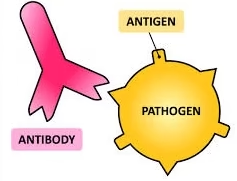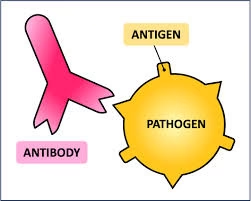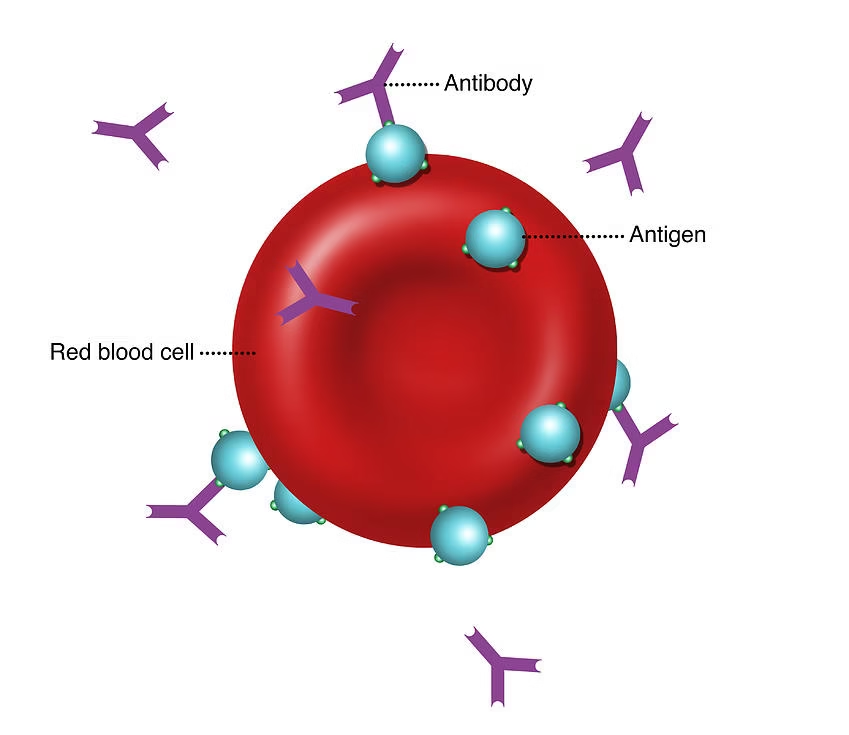
Antigens
- An antigen is any molecule or substance that can trigger an immune response in the body.
- Antigens can come from a variety of sources, including bacteria, viruses, fungi, and even cancerous cells.
- They are often large molecules, such as proteins, polysaccharides, or lipids, and are typically recognised by the immune system as foreign or non-self.

-
Types of Antigens: Antigens are classified based on their origin or how they are recognized by the immune system:
-
Exogenous Antigens: These come from outside the body, such as bacteria or viruses.
-
Endogenous Antigens: These are produced inside the body, such as those produced by cancer cells or viruses that have infected host cells.
-
Autoantigens: These are molecules from the body itself, but when the immune system mistakenly targets them, it can result in autoimmune diseases.
-
-
Immune System Recognition: The immune system detects antigens using specialized molecules called antibodies (immunoglobulins), which are proteins that can bind specifically to antigens. Other immune cells like T-cells also recognize antigens and help to destroy foreign invaders.
-
Importance of Antigens: Antigens are the key components for the body to distinguish between “self” (normal body cells) and “non-self” (foreign particles), which helps in defending the body from infections and diseases.
Immunogen
- An Immunogen is a type of antigen that can specifically trigger an immune response by stimulating the production of antibodies and the activation of immune cells.
- Immunogens are typically large, complex molecules that can be recognized as foreign.
-
Immunogenicity: The ability of a substance to stimulate an immune response is called immunogenicity. Immunogens are usually proteins or polysaccharides, which are able to stimulate both humoral (antibody-mediated) and cellular (T-cell mediated) immune responses.
-
Factors that Affect Immunogenicity:
-
Size: Larger molecules tend to be better immunogens because they have more surface areas for the immune system to recognize.
-
Complexity: The more complex the structure, the better the immune system can recognize it. This includes the presence of many different epitopes or antigenic determinants.
-
Foreignness: The more foreign the substance is to the body, the better it is at inducing an immune response. For example, a virus from outside the body is more likely to induce a strong immune response than something made from the body’s own tissues.
-
-
Examples of Immunogens:
-
Bacterial Proteins: Proteins on the surface of bacteria are often immunogenic and can lead to the production of antibodies against the pathogen.
-
Viral Proteins: Proteins on the surface of viruses, like the spike protein of the SARS-CoV-2 virus, are immunogenic.
-
-
Immunization: Vaccines are designed using immunogens to protect the body from future infections. These vaccines introduce the immunogen (e.g., a weakened virus or a fragment of the pathogen) so the body can prepare an immune response without causing disease.
Alloantigen
An alloantigen is an antigen that is found in some individuals but not in others of the same species. These are genetic variations in antigens that differ between members of the same species. For example, human blood groups (ABO, Rh factor) are determined by alloantigens.
-
Role in Transfusion and Organ Transplants:
-
Blood Transfusions: If a person receives blood from someone with different alloantigens, their immune system may treat the transfused blood as foreign and attack it. This is why it is crucial to match blood types (e.g., type A, B, AB, or O) before transfusions.
-
Organ Transplants: Organs from a donor may have different alloantigens compared to the recipient’s body. The recipient’s immune system may recognize these antigens as foreign and try to reject the transplanted organ. Immunosuppressive drugs are used to prevent this immune response in transplant recipients.
-
-
Examples of Alloantigens:
-
ABO Blood Group: The presence or absence of certain carbohydrate structures on red blood cells determines blood type. For example, type A blood has A antigens on red cells, while type B has B antigens.
-
Rh Factor: Another type of blood group antigen. People are either Rh-positive (have the Rh antigen) or Rh-negative (do not have it). If an Rh-negative person receives Rh-positive blood, their immune system may attack the foreign cells.
-
Soluble Antigen
A soluble antigen is a type of antigen that is not anchored to the surface of a cell but is freely circulating in the body’s fluids, such as blood or lymph. These are usually toxic proteins or metabolic products from pathogens that can trigger an immune response.
-
Examples of Soluble Antigens:
-
Bacterial Toxins: Some bacteria secrete toxic proteins, like the diphtheria toxin. These soluble antigens can enter the bloodstream and cause widespread immune responses.
-
Viral Proteins: Some viral proteins, such as the surface proteins of HIV, can be free-floating and stimulate an immune response.
-
Enzymes: Certain enzymes secreted by parasites or bacteria can also act as soluble antigens.
-
-
Immune Response to Soluble Antigens:
-
The immune system detects soluble antigens and produces antibodies that can neutralize the toxin or pathogen.
-
Soluble antigens can also be processed by antigen-presenting cells (APCs) that present parts of the antigen to T-cells, activating a cellular immune response.
-
Red Cell Antigen
Red cell antigens are molecules present on the surface of red blood cells. They are used to classify individuals based on their blood type, and mismatches in these antigens can cause serious immune reactions, particularly during blood transfusions.
-
Blood Groups: The most common red cell antigens are those that make up the ABO and Rh blood group systems.
-
ABO System: The presence or absence of two antigens, A and B, on the surface of red blood cells determines a person’s blood type. Type A has A antigens, type B has B antigens, type AB has both, and type O has none.
-
Rh System: The Rh antigen (or Rh factor) is another red cell antigen that can either be present (Rh-positive) or absent (Rh-negative). The presence of the Rh antigen is most important in pregnancy and blood transfusion.
-
-
Importance of Blood Transfusions: Red cell antigens are essential in matching blood types. Receiving blood with incompatible red cell antigens can trigger an immune reaction, leading to the destruction of the transfused blood cells.
-
Example of Mismatch: If an Rh-negative person receives Rh-positive blood, their immune system may recognize the Rh antigen as foreign and initiate an immune response, leading to hemolytic transfusion reactions.
-
-
Immune Response to Red Cell Antigens: If an individual’s immune system encounters incompatible red cell antigens (from transfusion or organ transplant), it may produce antibodies against these antigens, which will attack the foreign cells.
Epitopes
An epitope is the specific part of an antigen that is recognized by an antibody or a T-cell receptor. The immune system’s ability to recognize a pathogen or toxin is directly tied to the structure of the epitope.
-
Structure of Epitopes: Epitopes are often short amino acid sequences in proteins or specific sugar sequences in carbohydrates. They can either be:
-
Linear Epitopes: These consist of a continuous sequence of amino acids in a protein.
-
Conformational Epitopes: These are formed by the three-dimensional folding of the antigen, where different parts of the peptide chain come together in space, creating a specific shape recognized by antibodies.
-
-
Immune System Recognition: The immune system recognizes epitopes through:
-
B-cell receptors (antibodies): These can bind to the epitopes of antigens directly.
-
T-cell receptors: These recognize processed antigen fragments displayed on the surface of infected cells or antigen-presenting cells.
-
-
Importance in Vaccine Development: Vaccines often use specific epitopes to train the immune system. By introducing an epitope from a pathogen, the immune system is able to recognize and respond to the pathogen more effectively in the future.